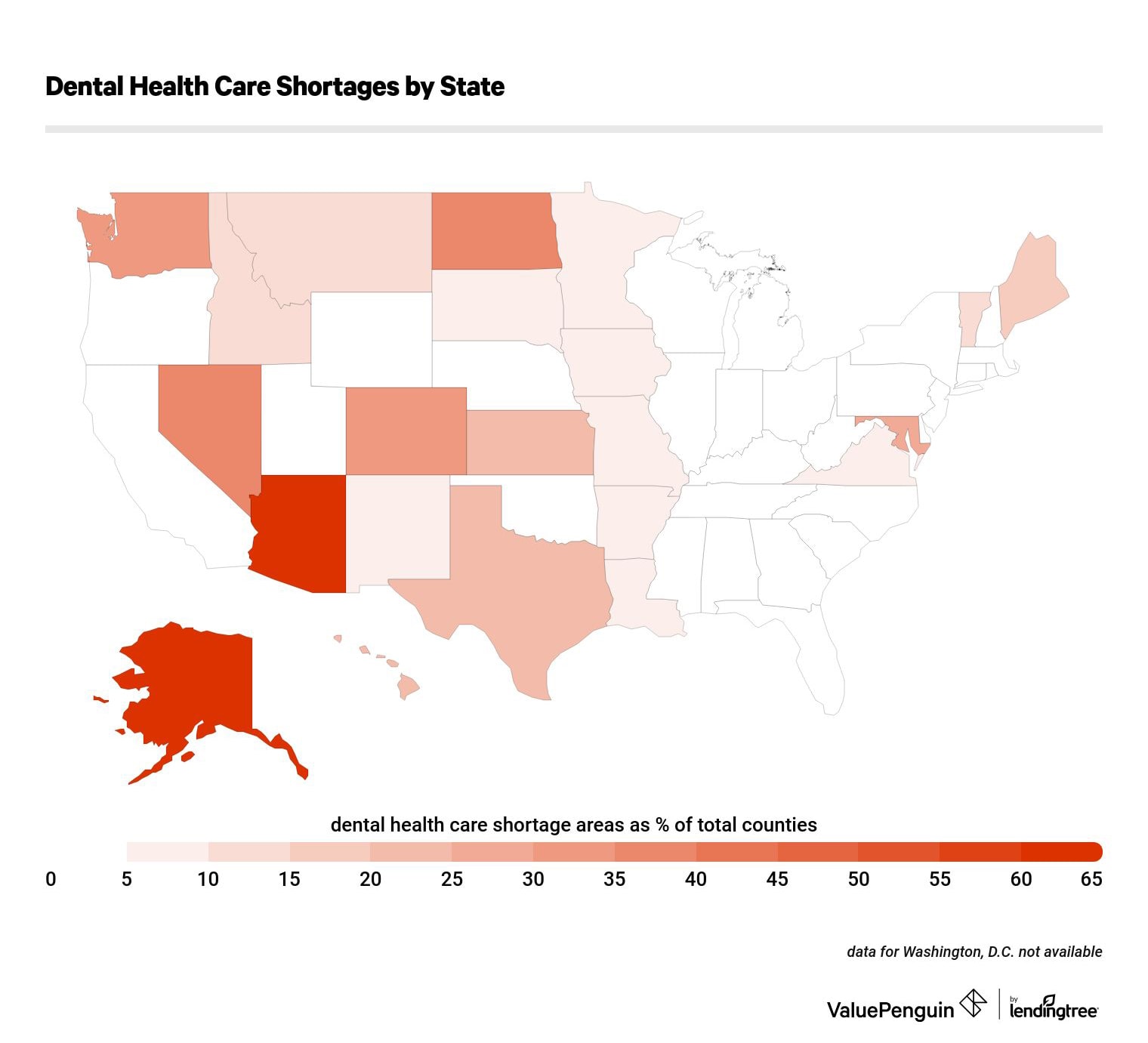Health Insurance
States with the Highest Healthcare Workforce Shortages

Nevada has the highest acute shortage in health care practitioners per 1,000 population, at 20.7

This practitioner-to-population ratio is 22% less than the national average of 26.40. California and Washington also rank near the bottom for availability of health care practitioners, with an average of 21.20 professionals per 1,000 residents. According to the Bureau of Labor Statistics, a health care practitioner includes professions such as:
- Primary care physicians
- Dentists
- Mental health practitioners
- Pharmacists
- Nurses
- Surgeons
- Psychiatrists
- Gynecologists
Conversely, the District of Columbia, South Dakota and Massachusetts have the highest ratios, with 46.57, 35.42 and 35.16 health care practitioners per 1,000 population, respectively.
Arizona, overall, has the most severe health care workforce shortages
Among the three core disciplines, Arizona actually faced the most shortages and ranked within the top three nationally. One hundred percent of counties within Arizona, according to the HRSA data, faced primary care and mental health practitioner shortages. This means that the counties in Arizona did not meet the minimum population-to-provider ratio. For primary care, this target ratio is 3,500 to one.
Additionally, 67% of counties in Arizona have dental health practitioner shortages.
Throughout the entire U.S., there was no other state that had similar shortages among the three disciplines. Nevada was the closest, ranking within the top 10 for both primary care as well as dental health shortages, at 63% and 38%, respectively.
However, 95% of counties within Nevada have the optimal level of mental health professionals.
Along with Arizona, Hawaii and Alaska reported over 80% of their counties having primary care shortages
California, Maine and Utah rounded out the primary care shortage top 10 with 60%, 44% and 41% of counties having an acute shortage, respectively. The average percentage of counties per state with primary care shortages is 29%.
On the other hand, Connecticut and New Jersey are the only states where 100% of counties do not have any primary care professional shortages.

Maine, Texas, Washington, Alaska and Arizona ranked within the top five for mental health shortages
Fifty-eight percent of counties have a shortage of mental health professionals in Texas, which is the highest shortage percentage among the three disciplines for the state. Additionally, this was significantly higher than the average percentage of mental health shortages in a state, which is 16%.
Mental health professional shortages are the second worst of the three health disciplines analyzed. In fact, in Connecticut — which has zero underserved counties in primary and dental health — 25% of counties are currently experiencing a mental health professional shortage.

Alaska and Arizona are the only states that have a dental health shortage in over 50% of counties
Colorado reported having its highest shortage within the dental health discipline, showing a shortage in 31% of the state. On the same note, this is the only discipline in which Maryland appears to have a large shortage — 25% of counties reported lacking dental health practitioners.

On the other hand, California, a state that has large shortages in primary care and mental health, has an adequate number of dental health professionals in 97% of counties. Similarly, New Jersey was the only state in the nation that has zero counties with shortages in any of the three disciplines.
For 2019, over 53% of the total primary care practitioners deficit was in non-rural areas
Furthermore, non-rural practitioner needs were almost double the amount needed for counties in rural areas of the U.S.
Rural status | Practitioners needed to meet minimum requirement |
|---|---|
| Rural | 3,850 |
| Non-rural | 7,679 |
| Partially rural | 2,852 |
| Unknown | 11 |
The rural status designation is based on the geographic area of the county and is determined by the HRSA. A status of non-rural indicates that the county has a significant percent of the total state population or a major city within that area.
Complete state rankings of health care practitioners
Rank | State | Health care practitioners per 1,000 population | Primary care shortage | Mental health shortage | Dental health shortage |
|---|---|---|---|---|---|
| 1 | Nevada | 20.70 | 63% | 0% | 38% |
| 2 | California | 21.20 | 60% | 19% | 3% |
| 3 | Washington | 21.93 | 41% | 64% | 33% |
| 4 | Utah | 22.09 | 41% | 21% | 3% |
| 5 | Hawaii | 22.29 | 80% | 40% | 20% |
| 6 | New Mexico | 22.40 | 27% | 9% | 6% |
| 7 | Arizona | 22.52 | 100% | 100% | 67% |
| 8 | Idaho | 22.85 | 30% | 14% | 11% |
| 9 | Georgia | 23.56 | 9% | 4% | 4% |
| 10 | Texas | 23.66 | 34% | 58% | 20% |
| 11 | Alaska | 24.07 | 79% | 89% | 63% |
| 12 | Oregon | 24.53 | 25% | 3% | 0% |
Methodology
In this health care workforce study, ValuePenguin compiled data from two databases: The U.S. Bureau of Labor Statistics (BLS) and the Health Resources & Services Administration (HRSA).
Using the BLS query system, health care practitioner data was pulled nationally and by state from the most recent year available, which in this case was for 2018. Then, using the HRSA database, year-end 2019 data was pulled regarding health care professional shortage areas (HPSAs) and aggregated by state.
